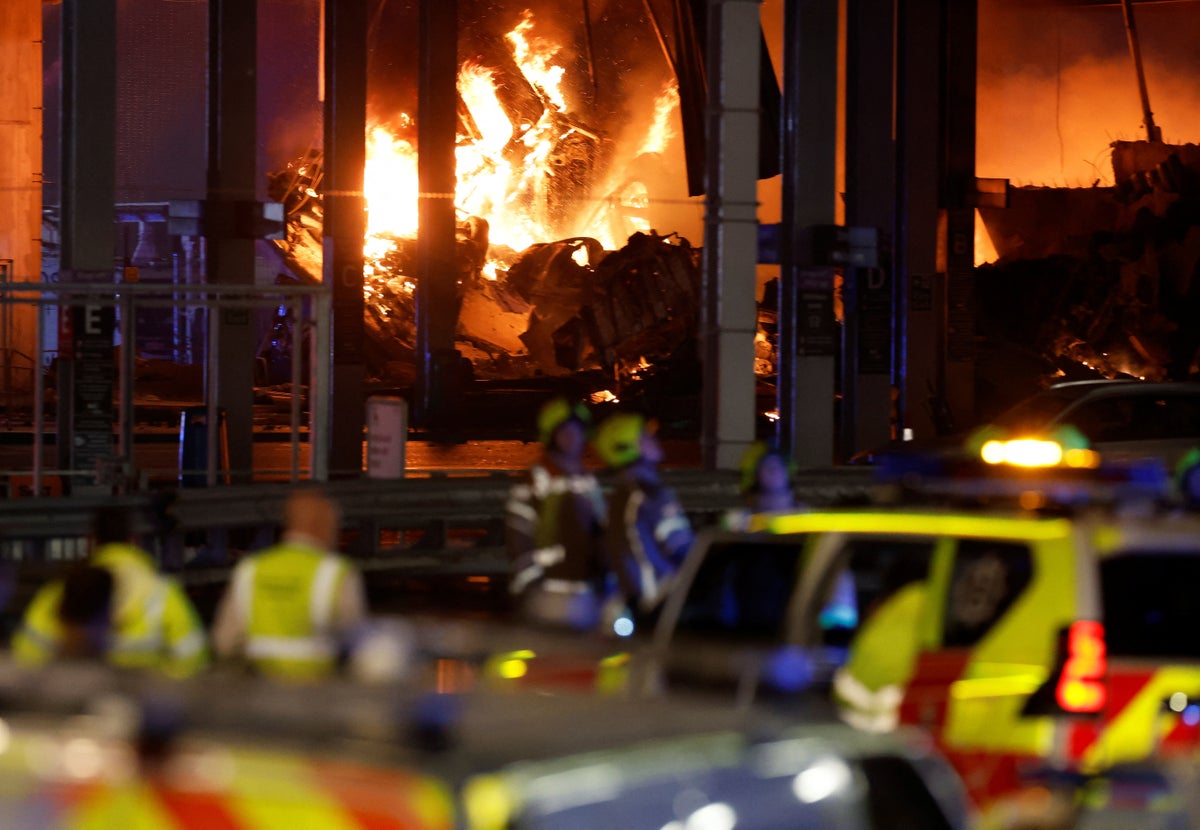[ad_1]
The cause of the huge blaze at London’s Luton Airport that has damaged up to 1,500 cars has been revealed.
Over 100 firefighters battled through the night to extinguish the car park inferno, which has left thousands of passengers affected by diversion and cancellations.
With flights set to be disrupted for most of the day, Bedfordshire Fire and Rescue Service has now revealed the cause of the blaze was a diesel car.
“We don’t believe it was an electric vehicle,” Andrew Hopkinson, chief fire officer for Bedfordshire Fire and Rescue Service, said.
“It’s believed to be diesel-powered, at this stage all subject to verification. And then that fire has quickly and rapidly spread.”
Up to 1,500 vehicles may have been in the car park at the time of the fire and subsequently damaged and the airport has suspended all flights until 3pm on Wednesday.
Around 25,000 passengers are suffering flight disruption as Luton Airport remains closed because a vehicle fire caused a car park to collapse
(PA Media)
The newly-built car park building at the airport’s Terminal 2 partially collapsed after a fire broke out at around 9pm, the fire service said.
Mr Hopkinson said the fire service first received the first report about the blaze at 8.47pm and its first two appliances arrived at the scene just under 10 minutes later.
The fire was on the third floor of the terminal car park two and a major incident was declared at 9:38pm.
Speaking to reporters at the scene, he said: “On arrival my officers were faced with a severe and rapidly spreading fire involving a large number of vehicles that ultimately spread to multiple floors and involved a partial collapse of the car park.”
AA technical expert Greg Carter said the most common cause of car fires is an electrical fault with the 12-volt battery system.
He added that diesel is “much less flammable” than petrol, and in a car it takes “intense pressure or sustained flame” to ignite diesel.
There were no reports of injuries to members of the public, but five people, four firefighters and an airline official, were treated in hospital.
Between 40,000 – 50,000 passengers are thought to be affected by 273 suspended, cancelled or diverted flights.
Over 100 firefighters and 15 fire appliances were used at the peak of the fire, which was eventually distinguished this morning.
Aftermath of the blaze which damaged up to 1,500 cars
(PA Wire)
The fire service posted on X on Wednesday morning: “The fire service have now scaled back at Luton Airport and this is no longer a major incident. A number of agencies have been released from the scene and we continue to work with colleagues from the airport and police.”
They added that the fire service would continue to be on the scene for the rest of the day.
Mr Hopskinson also revealed reporters at the scene that there were no sprinklers in the car park.
He said: “We are already talking to the airport about ensuring that any future, and the existing, car parks have sprinklers fitted because this building is not sprinkler protected.”
“Sprinklers may have made a positive impact on this incident.”
(REUTERS)
People with cars affected have been advised to refer to the Luton Airport website for further information.
Mr Hopkinson told reporters that a ramp is being installed “into the unaffected car park because the normal exit route is not safe to take vehicles out”.
He went on: “We’ve currently got four fire appliances and a couple of other specialist crews but we are very much focused on getting a handover and getting this airport open as quickly as we can.”
He added: “There is a substantial number that are not damaged and our focus as well is can we remove those vehicles safely without causing any danger to the responders?”
Passengers wait at Luton Airport after flights cancelled until Wednesday afternoon
(Simon Calder)
Officials have confirmed to The Independent that arrivals and departures will resume at Luton airport at 3pm. By that stage 120 outbound flights are likely to have been cancelled – though some airlines may hold earlier flights to depart after operations start up.
A temporary drop-off zone will be installed at the mid-term car park, close to the Holiday Inn Express, a 10-minute walk from the airport terminal. Buses may provide a shuttle service.
The Independent understands that airlines such as Ryanair and Wizz Air will despatch aircraft to Luton ahead of the 3pm reopening.
[ad_2]
Source link




